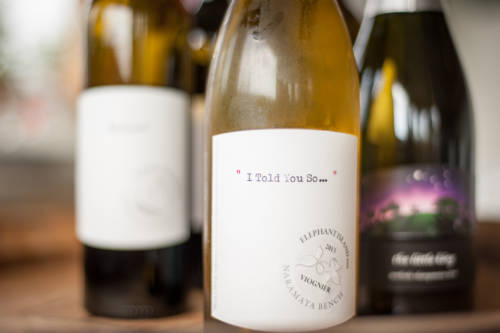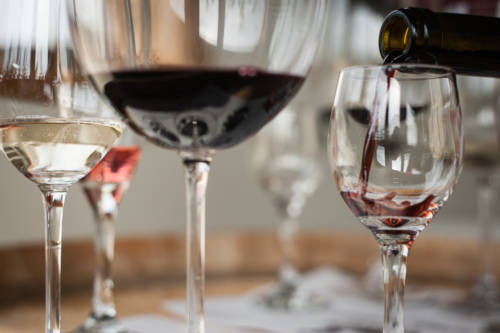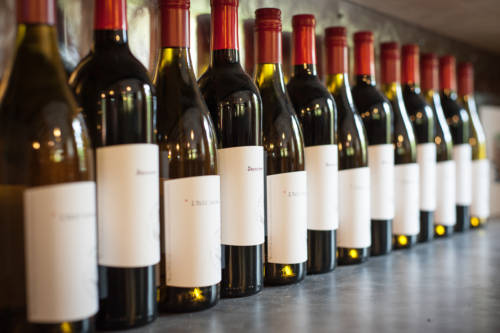
Picnics in The Orchard: Discovering The Tantalizing Fruit Wines of Elephant Island
“To me, picnics in the orchard were so memorable and magical. We’d marvel at what bugs might wander through or what tree root might tip our uncle’s chair. The orchard was my Secret Garden, in a way…” — Miranda Halladay, Proprietor, Elephant Island Orchard
In the Southern Interior region of British Columbia, Canada lies every wine lover’s dream: The Okanagan Valley. In this area, you’ll find a terroir that’s rich with different soil types and microclimates that lend themselves well to winemaking. With 9,900 acres of vineyards and counting, a wide range of varietals hail from this region, many of which are lauded as some of the world’s best wines.
But at Elephant Island Orchard, you won’t discover just any vintage of pinot noir, merlot, or riesling; here you’ll find complex fruit wines made with a unique twist on tradition. And, much like the old cherry trees that line the property, Elephant Island Orchard has roots that run deep. GC caught up with Miranda Halladay, who runs Elephant Island Orchard along with her husband, to discuss her unique family history and philosophy on winemaking.
Grandmother Catherine
The family history behind Elephant Island Orchard largely points back to one strong personality in Miranda’s world: her grandmother. Grandmother Catherine was an architect—one of the first female architects in Canada, actually.
Grandmother Catherine and Grandfather Paul were looking to invest in a retirement property in a place that was a bit less hurried. They loved the Okanagan, so they ultimately fell in love with the orchard. Grandfather Paul, an engineer and Mad Scientist at heart, believed there was a market for well-crafted fruit wines, and his recreational pursuit of winemaking would prove advantageous to the demand.
Picnics in the Orchard
Miranda recalls her early memories of the orchard and the decadent treats her grandfather would prepare for picnics. “When I was growing up, everything seemed so vast here,” she told Garden Collage. “It’s five acres, which isn’t a huge property by any stretch, but the way the orchards were planted created this Mad Hatter Tea Party sort of feel…”
“It’s five acres, which isn’t a huge property by any stretch, but the way the orchards were planted created this Mad Hatter Tea Party sort of feel…”
“For picnics, my granddad would make these beautiful tortes that would take days to prepare,” she lovingly recalled. “He’d grind a special nut flower and mix everything together into this incredibly rich and delicious cake that we’d only have once a year because it was such a production to execute.”
But unlike Grandfather Paul’s elaborate desserts, cherries were never in short supply in the orchard. This tangy fruit made a regular appearance at family picnics and became the vanguard fruit of Elephant Island Orchard’s unique wines. Grandfather Paul’s Dubonnet was a cherry-based wine that was crafted from the fruit he harvested from the orchard, which led to “all sorts of experiments of the alcoholic variety,” Miranda recalls.
Growing Conditions & Harvesting
To make cherry wine, the winemaker converts the natural sugars into alcohol, just like a traditional wine. “The challenges, from a winemaking perspective, come in the physical handling of the fruit,” Miranda tells us. According to Miranda, the stems impart a “green” flavor to the wines, so the cherries are picked with no stems. “Cherries also have a pit that you have to deal with, and they ripen at one of the hottest times of the year,” Miranda says. “The second challenge is controlling the fermentation and maintaining the quality of the fruit when it’s so hot out.”
“Cherries have fewer tannins than a red grape, so most people find cherry wine has a more supple finish than a conventional red grape wine,” Halladay says.
Once the cherries are harvested, the winemaker treats them just like red grapes: they’re crushed, pressed, and fermented on the skin. The trick, at that stage, is to ensure that they’re not breaking too many of the pits. “The pits create bitterness, but they also have cyanide in them, so we don’t want too much of that element being introduced into the wine. Allowing fermentation to take place on the pit adds this lovely sort of nuttiness and richness to the finished wine.”
Elephant Island is into its sixteenth vintage now, and they’re still learning and identifying growing conditions that have an impact. “The vintage that came out of 2015 was probably the best cherry wine we’ve ever produced,” Miranda says. “This wine is dry but supple, with a hint of fresh Naramata cherries, a chocolatey richness, and a kiss of almond on the finish.”
The Art of Flavorful Pairing
Miranda is often asked to explain the difference between a fruit wine and a conventional grape wine. “Cherries have fewer tannins than a red grape, so most people find cherry wine has a more supple finish than a conventional red grape wine,” she says. “Some people say it’s like an older pinot noir with very soft tannins.”
“Cherry wines are versatile and pair well with a range of foods, from tomato-based dishes to duck and venison,” Miranda says. Her favorite, especially at this time of year, is cherry wine with a white bean and sausage casserole, a suggestion of an alternative wine experience that sounds as intriguing as it does rogue. When it comes to wine—and life, for that matter—a hint of rebellion makes the mix a whole lot sweeter.





































